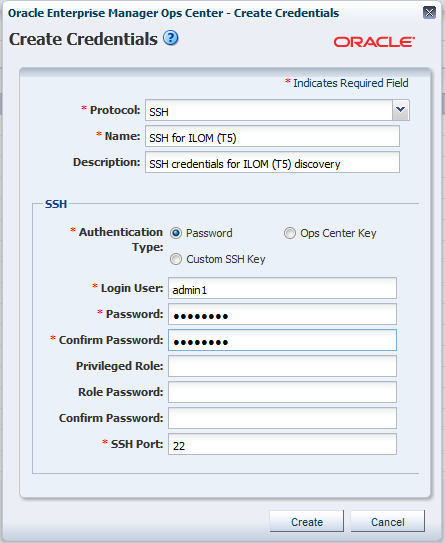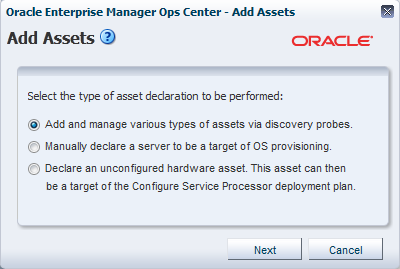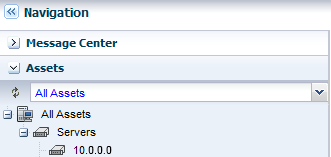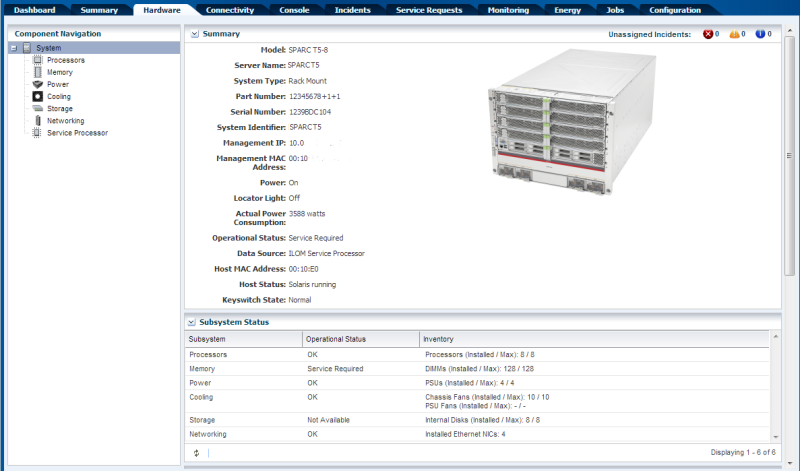Oracle® Enterprise Manager Ops Center
Discover and Manage SPARC T5 Series Servers and SPARC T7 Series Servers
12c Release 3 (12.3.2.0.0)
E60000-03
July 2016
This guide provides an end-to-end example for how to use Oracle Enterprise Manager Ops Center.
Introduction
Use Oracle Enterprise Manager Ops Center to discover, manage, and monitor SPARC T5 Series servers and SPARC T7 Series servers.
You can use Oracle Enterprise Manager Ops Center to manage and monitor a variety of data center assets, including server hardware, chassis, racks, network equipment, operating systems, virtualization software, and clustering software. Discovering and managing your assets is a prerequisite for almost every action in the software. The discovery feature makes adding assets quick and easy by using a discovery profile and running an Add Assets job. The discovery profile specifies the type of targets to discover and the credentials and protocols to access them and to manage them. You can discover one server or many servers in the same operation efficiently and consistently.
All SPARC T5 series servers and SPARC T7 series servers have an ILOM 3.2 service processor, which uses the Simplified Data Model (SDM) to present information consistently across different types of servers. SDM is an option on SPARC T5 series servers.
SPARC T7 series servers:
-
T7-1B, server module with one CPU socket.
-
T7-1, one CPU sockets
-
T7-2, two CPU sockets
-
T7-4, four CPU sockets
SPARC T5 series servers:
-
T5-1B, server module with one CPU socket.
-
T5-2, two CPU sockets
-
T5-4, four CPU sockets
-
T5-8, eight CPU sockets
Note:
The example scenario demonstrates the discovery for a SPARC T5–8 Server. You can use the same procedure to discover any of the SPARC T5 series servers or SPARC T7 series servers.You can view a short video of this procedure, Discovering and Managing a SPARC T7 Series Server or SPARC T5 Series Server.
What You Will Need
Requirements for discovering a SPARC T5 series server or SPARC T7 series server using Oracle Enterprise Manager Ops Center.
You will need the following:
-
Access to a system running Oracle Enterprise Manager Ops Center.
-
Ops Center Admin role to discover assets and the Ops Center Security Admin role to create credentials.
-
One or more SPARC T7 series servers or T5 series servers with a configured ILOM service processor.
-
Intelligent Platform Management Interface (IPMI) and SSH credentials for the ILOM service processor.
Discover a SPARC T7 Series Server or SPARC T5 Series Server
General procedure for discovering a SPARC T5 series server or SPARC T7 series server using Oracle Enterprise Manager Ops Center.
To discover the server, use a discovery profile with the Add Assets action. A discovery profile is a combination of an asset type, a set of host names or IP addresses, and a set of credentials. The following steps discover and manage one or many servers:
Creating Credentials
Credentials used for discovering an Oracle SPARC T5 or T7 server using Oracle Enterprise Manager Ops Center.
You must provide a set of new or existing credentials to grant Oracle Enterprise Manager Ops Center access to the ILOM service processor. For a server with an ILOM service processor, use IPMI and SSH credentials. This example creates both types of credentials.
Creating IPMI Credentials
Procedure for using IPMI protocol to discover a SPARC T7 series server or SPARC T5 series server using Oracle Enterprise Manager Ops Center.
Use this procedure to create credentials using the IPMI protocol.
- Click Plan Management on the Navigation pane, then click Credentials.
- Click Create Credentials on the Actions pane. The Create Credentials wizard opens.
- Select IPMI from the drop-down list in the Protocol field.
- Enter a name for the discovery credentials in the Name field.
- Enter a description for your credentials in the Description field.
- Enter the user name of the service processor login credentials in the Login User field.
- Enter the password of the service processor login credentials in the Password field. Then, retype the same password in the Confirm Password field.
- Click Create. The IPMI credentials are displayed in the Credentials table.
Creating a Discovery Profile
Use a profile to discover assets in Oracle Enterprise Manager Ops Center and to repeat the discovery operation.
Discovery profiles simplify managing multiple sets of criteria and provide persistent storage of access credentials. You create a discovery profile and then use it to discover assets that match the criteria. This example includes the credentials and network information in the discovery profile, but you can provide this information at the time you run the discovery job.
Using the Discovery Profile
Procedure for using a discovery profile to discover an ILOM server using Oracle Enterprise Manager Ops Center.
After you have created the discovery profile, use it to discover and manage the server:
After the discovery job completes successfully, the service processor is visible in the Navigation pane under the Servers tree, located in the Assets pane as shown in the following figure.
What's Next?
Description of post-discovery tasks for SPARC T7 series servers or SPARC T5 series servers in Oracle Enterprise Manager Ops Center.
After you have discovered the server, you can manage and monitor it as a datacenter asset.
You can also discover and manage the server’s operating system. The SPARC T7 series server uses the Oracle Solaris 11.3 operating system. The SPARC T5 series server can use either Oracle Solaris 10 or Oracle Solaris 11.
Note:
To use Oracle VM Server for SPARC software on a SPARC T5 series server, the server’s operating system be a minimum of Oracle Solaris 10 update 11.
See the Deploy Operating Systems Workflow in the Deploy How To library at http://docs.oracle.com/cd/E59957_01/nav/deploy.htm.
Related Articles and Resources
You can view a short video of this procedure, Discovering and Managing a SPARC T7 Series Server or SPARC T5 Series Server, located in the documentation library.
See the following for more information:
-
Manage Assetsof the Oracle Enterprise Manager Configuration Reference for information about discovery procedures for different types of servers. -
Hardwareof the Oracle Enterprise Manager Operations Reference for information about managing and monitoring hardware assets. -
Operating Systems Provisioningof the Oracle Enterprise Manager Operations Reference for information about provisioning operating systems on hardware servers.
For more information about SPARC servers and ILOM configuration, see the SPARC Systems library and the Systems Management and Diagnostics library in the Servers, Systems Management, Workstations, and Related Hardware section of http://docs.oracle.com.
Oracle® Enterprise Manager Ops Center Discover and Manage SPARC T5 Series Servers and SPARC T7 Series Servers, 12c Release 3 (12.3.2.0.0)
E60000-03
Copyright © 2007, 2016, Oracle and/or its affiliates. All rights reserved.
This software and related documentation are provided under a license agreement containing restrictions on use and disclosure and are protected by intellectual property laws. Except as expressly permitted in your license agreement or allowed by law, you may not use, copy, reproduce, translate, broadcast, modify, license, transmit, distribute, exhibit, perform, publish, or display any part, in any form, or by any means. Reverse engineering, disassembly, or decompilation of this software, unless required by law for interoperability, is prohibited.
The information contained herein is subject to change without notice and is not warranted to be error-free. If you find any errors, please report them to us in writing.
If this is software or related documentation that is delivered to the U.S. Government or anyone licensing it on behalf of the U.S. Government, then the following notice is applicable:
U.S. GOVERNMENT END USERS: Oracle programs, including any operating system, integrated software, any programs installed on the hardware, and/or documentation, delivered to U.S. Government end users are "commercial computer software" pursuant to the applicable Federal Acquisition Regulation and agency-specific supplemental regulations. As such, use, duplication, disclosure, modification, and adaptation of the programs, including any operating system, integrated software, any programs installed on the hardware, and/or documentation, shall be subject to license terms and license restrictions applicable to the programs. No other rights are granted to the U.S. Government.
This software or hardware is developed for general use in a variety of information management applications. It is not developed or intended for use in any inherently dangerous applications, including applications that may create a risk of personal injury. If you use this software or hardware in dangerous applications, then you shall be responsible to take all appropriate fail-safe, backup, redundancy, and other measures to ensure its safe use. Oracle Corporation and its affiliates disclaim any liability for any damages caused by use of this software or hardware in dangerous applications.
Oracle and Java are registered trademarks of Oracle and/or its affiliates. Other names may be trademarks of their respective owners.
Intel and Intel Xeon are trademarks or registered trademarks of Intel Corporation. All SPARC trademarks are used under license and are trademarks or registered trademarks of SPARC International, Inc. AMD, Opteron, the AMD logo, and the AMD Opteron logo are trademarks or registered trademarks of Advanced Micro Devices. UNIX is a registered trademark of The Open Group.
This software or hardware and documentation may provide access to or information about content, products, and services from third parties. Oracle Corporation and its affiliates are not responsible for and expressly disclaim all warranties of any kind with respect to third-party content, products, and services unless otherwise set forth in an applicable agreement between you and Oracle. Oracle Corporation and its affiliates will not be responsible for any loss, costs, or damages incurred due to your access to or use of third-party content, products, or services, except as set forth in an applicable agreement between you and Oracle.







